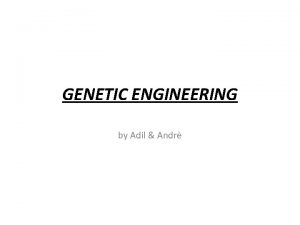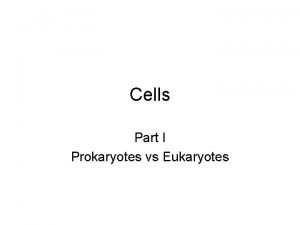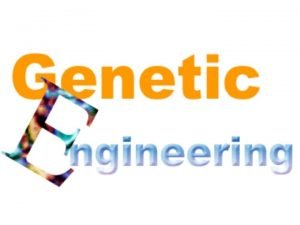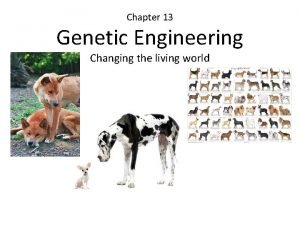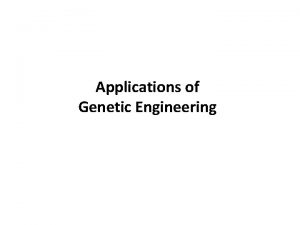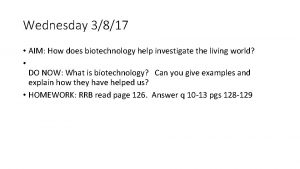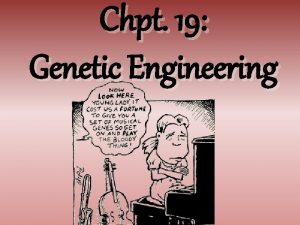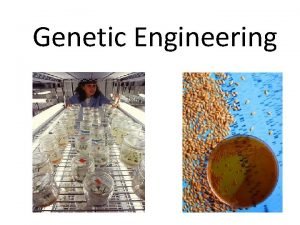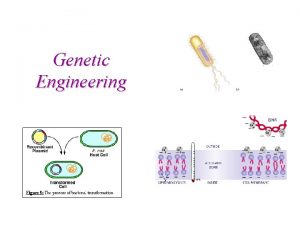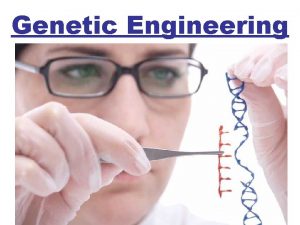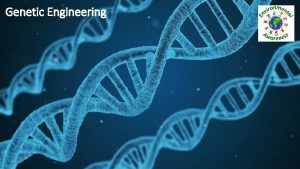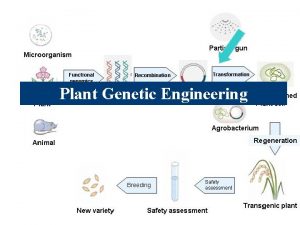The Plant World and Genetic Engineering Part I















- Slides: 15

The Plant World and Genetic Engineering Part I Transgenic Plants Jana Klose, Greg Lampard UBC Biotechnology Laboratory

What Is Biotechnology? • Harnessing the natural biological processes of living systems for the benefit of mankind • Biotechnology in the past – making bread and cheese, brewing beer – crossbreeding plants • Modern biotechnology – genetic engineering

Genetic Engineering • The process of manipulating and transferring instructions carried by genes from one cell to another Why do scientists want to change gene instructions? • to produce needed chemicals • to carry out useful processes • to give an organism desired characteristics

DNA IS EVERYWHERE

DNA and Genes • Genes = the coding system for instructions • A gene = is a segment of DNA Guanine (G) Cytosine (C) Adenine (A) Thymine (T) bases DNA gene

Genes and Proteins transcription m. RNA Gene (a piece of DNA) protein translation trait

Restriction enzymes As biological scissors

Plant Genetic Engineering Transgenic Plants • the product of plant genetic engineering Genetically Modified Organism (GMO) Genetically Engineered Organism (GEO) • the label for transgenic plants

Plant Genetic Engineering Process Cell Plant cell Extracted DNA A single gene Transformation Transgenic plant Cell division

How are Transgenic Plants Produced? Commonly Used Methods: • Agrobacterium tumefaciens • Gene Gun / Biolistics • Electroporation

Agrobacterium tumefaciens Agrobacterium Genomic DNA Ti plasmid Plant cell (carries the gene of interest) interest Restriction enzyme A + Empty plasmid Gene of interest Ti plasmid with the gene of interest

Agrobacterium tumefaciens Ti plasmid with the new gene cell’s DNA + Agrobacterium Transformation Plant cell The new gene Transgenic plant Cell division

“Gene Gun” Technique DNA coated golden particles Gene gun Cell’s DNA Plant cell A plant cell with the new gene Transgenic plant Cell division

Power supply Plant cell Electroporation Technique Duracell Protoplast DNA containing the gene of interest DNA inside the plant cell The plant cell with the new gene

Next Generation of Transgenic Crops • • • Plant-based vaccines Enhanced nutritional content Functional foods and phytoceuticals Transgenic plants for phytoremediation Plant-derived plastics and polymers
 Founder effect genetic drift
Founder effect genetic drift Genetic programming vs genetic algorithm
Genetic programming vs genetic algorithm Genetic programming vs genetic algorithm
Genetic programming vs genetic algorithm Genetic drift vs gene flow
Genetic drift vs gene flow Gene flow vs genetic drift
Gene flow vs genetic drift Oryx and crake genetic engineering
Oryx and crake genetic engineering Pro genetic engineering
Pro genetic engineering Chapter 3 cells and tissues
Chapter 3 cells and tissues Which part of the cell contains genetic material
Which part of the cell contains genetic material Insulin bacteria genetic engineering
Insulin bacteria genetic engineering Section 13-1 changing the living world
Section 13-1 changing the living world Genetic engineering applications
Genetic engineering applications Genetic engineering steps
Genetic engineering steps Purpose of genetic engineering
Purpose of genetic engineering Source russia march
Source russia march Gene pharming
Gene pharming






